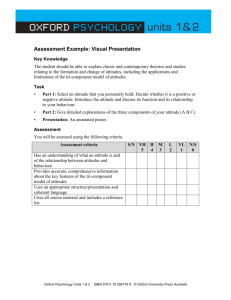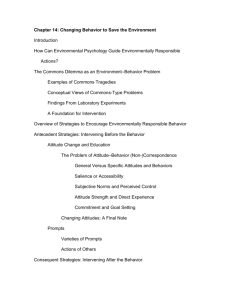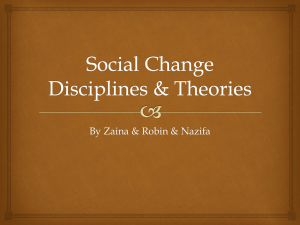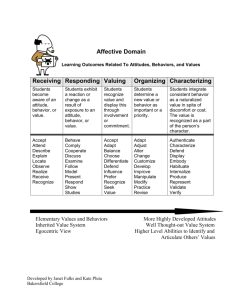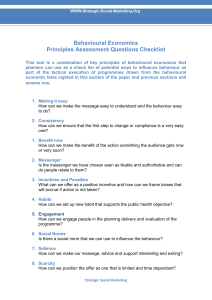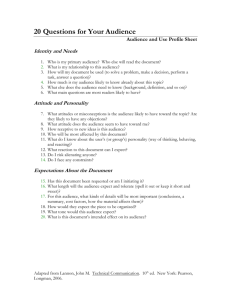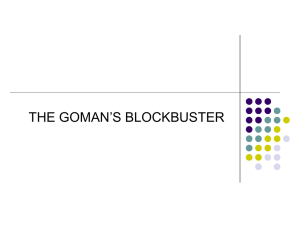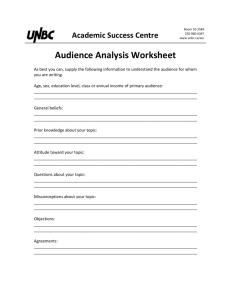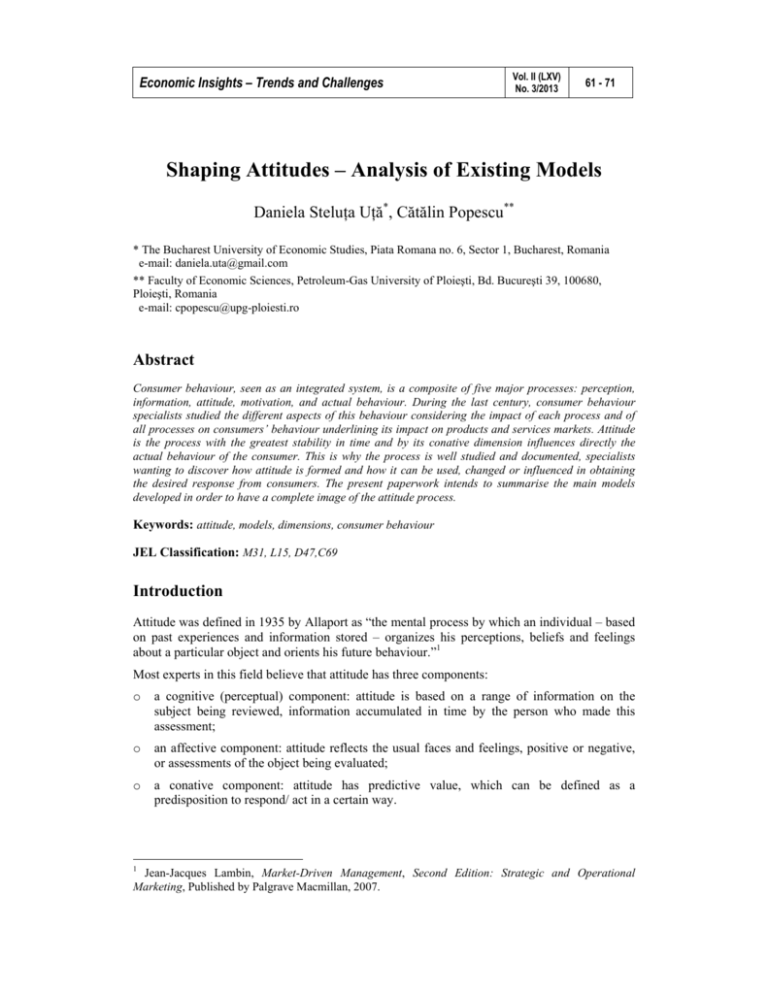
Economic Insights – Trends and Challenges
Vol. II (LXV)
No. 3/2013
61 - 71
Shaping Attitudes – Analysis of Existing Models
Daniela Steluţa Uţă*, Cătălin Popescu**
* The Bucharest University of Economic Studies, Piata Romana no. 6, Sector 1, Bucharest, Romania
e-mail: daniela.uta@gmail.com
** Faculty of Economic Sciences, Petroleum-Gas University of Ploieşti, Bd. Bucureşti 39, 100680,
Ploieşti, Romania
e-mail: cpopescu@upg-ploiesti.ro
Abstract
Consumer behaviour, seen as an integrated system, is a composite of five major processes: perception,
information, attitude, motivation, and actual behaviour. During the last century, consumer behaviour
specialists studied the different aspects of this behaviour considering the impact of each process and of
all processes on consumers’ behaviour underlining its impact on products and services markets. Attitude
is the process with the greatest stability in time and by its conative dimension influences directly the
actual behaviour of the consumer. This is why the process is well studied and documented, specialists
wanting to discover how attitude is formed and how it can be used, changed or influenced in obtaining
the desired response from consumers. The present paperwork intends to summarise the main models
developed in order to have a complete image of the attitude process.
Keywords: attitude, models, dimensions, consumer behaviour
JEL Classification: M31, L15, D47,C69
Introduction
Attitude was defined in 1935 by Allaport as “the mental process by which an individual – based
on past experiences and information stored – organizes his perceptions, beliefs and feelings
about a particular object and orients his future behaviour.”1
Most experts in this field believe that attitude has three components:
o
a cognitive (perceptual) component: attitude is based on a range of information on the
subject being reviewed, information accumulated in time by the person who made this
assessment;
o
an affective component: attitude reflects the usual faces and feelings, positive or negative,
or assessments of the object being evaluated;
o
a conative component: attitude has predictive value, which can be defined as a
predisposition to respond/ act in a certain way.
1
Jean-Jacques Lambin, Market-Driven Management, Second Edition: Strategic and Operational
Marketing, Published by Palgrave Macmillan, 2007.
62
Daniela Steluţa Uţă, Cătălin Popescu
Psychologists and sociologists also believe that attitude persists, it can be modified, it is
structured in the sense in which internal consistency is based on evaluation criteria, and its
intensity can vary widely.
Many of the models developed by specialists are based on the theory of cognitive consistency
(coherence).The usefulness of these models depends largely on their explanatory or predictive
value.
According to the principle of cognitive consistency, consumers value harmony between
thoughts, feelings and behaviour and need to maintain consistency between these elements, this
need motivates the need to have certain behaviour. This desire for harmonization may make the
consumers change their feelings, thoughts or behaviour to comply with lived experiences.
Cognitive consistency principle always reminds that attitudes do not form “out of nothing” but
they are linked to other processes of consumer behaviour. An important factor in the formation
of a new attitude is how it fits existing attitudes.
The explanatory value of the models presupposes a structural approach of the cognitive and
affective components. The predictive value aims mainly at the relationship between the
emotional component, the conative and that actual consumer behaviour.
Defining Attitude through Specific Models
Cognitive theorists2 define attitude to an object as a composite between the perceived usefulness
of an object, as a means to achieve certain objectives and the relative importance of these
objectives. The model takes into account the strength (power) of the individual beliefs about the
object.
The usual form of additive models adapted to situations in marketing was developed by
Fishbein (1967) and Bass and Tarlarzyk (1969)3 and can be used as follows:
A ij =
n
∑W
k =1
ik
. X ijk ,
(1)
where:
Aij = the individual’s (j) attitude toward the brand (i);
Wik = the relative importance of attribute k for individual j;
X ijk = the extent to which the individual (j) believes that brand (i) possesses attribute (k);
n = number of attributes taken into account.
Over time, this formula has undergone various changes, depending on how the experts felt that
each individual component of attitude influences his decision to purchase.
Initially, Rosenberg (1956) – based on the functional approach to attitudes – started from the
assumption that a consumer’s attitude towards a particular good is accompanied by a cognitive
structure constructed from a consumer’s beliefs about the potential of a good to provide or not
the expected value. The more a property leads to a positive state or a state does not lead to a
2
George, S., Day, Evaluating Models of Attitude Structure, Journal of Marketing Research, 1975
Joel, B., Cohen, Martin, Fishbein and O., T. Ahtola, The Nature and Uses of Expectancy-Value Models,
Journal of Marketing Research, Vol. IX, November 1972, pp. 456-460
3
Shaping Attitudes – Analysis of Existing Models
63
significantly negative state, the more a consumer will have a positive attitude for the respective
good4. Rosenberg’s hypothesis has the following algebraic expression:
N
Aio = ∑ I i .Vi ,
(2)
i =1
where:
Ii = the extent to which a person is convinced that the object will lead or not to obtain the value
(i);
Vi = the importance of the value (i) as a source of satisfaction;
N = number of values taken into account.
Note that Rosenberg considered V as a measure of satisfaction or evaluation. According to
specialists, values, consequences and attributes are important only insofar as they provide
maximum consumer satisfaction or dissatisfaction.
Fishbein (1972) defines an individual’s attitude toward an object as a function of cumulative
individual’s beliefs about an object and evaluative aspect of those beliefs.
N
Ao = ∑ Bi .ai ,
(3)
i =1
where:
Bi = strength of belief „i” about the object of the attitude; “o” - the likelihood that the object
will be in relation to another object x (i.e., the probability that a brand of soft drinks is
carbonated);
ai = the evaluative aspect of Bi (assessment of carbonation);
N = number of beliefs taken into account.
In 1975, George S. Day5 pointed out three weaknesses of the model developed by Fishbein:
o
use of measurement or evaluation attributes requires comparative judgments rather than
absolute judgments. For example, semantic differential - which is often used - tends to
cause some confusion between the level of importance and the power of evaluation. Day
proposes that the measuring instrument should be the constant sum scale that asks
respondents to distribute a part of a predefined set of evaluation points for each attribute or
object;
o
another shortcoming of the model is that it neglects information on the stability in time of
the attitude. However, it was demonstrated that the attitude stability may vary depending on
the involvement of the respondent and the correctness of his judgment. Day (1975) believes
that one should also take into consideration the confidence shown by the respondent prior to
assessing his attitude towards an object. He suggests removing from the study group those
people who have a low level of confidence, thus increasing the quality of research results;
o
a third criticism is the fact that evaluation and affective judgments are not necessarily
synonymous and that the choice of an object depends on how well it meets the qualities
desired by the consumer.
4
Martin J., Rosenberg, Cognitive behavioural structure of Affect”, Journal of Abnormal and Social
Psychology, 1956
5
George, S., Day, Evaluating Models of attitude structure, Journal of Marketing Research, 1975, pg.281
64
Daniela Steluţa Uţă, Cătălin Popescu
This approach was used by Lehmann (1973) to predict preferences for the TV shows and he
created the following model:
n
AS = ∑ W J PSJ − I J ,
(4)
J =1
where:
AS = preference for the TV show measured as the distance to the ideal point;
WJ = measure of the importance attached to attribute j;
Psj = the extent to which the show meets the respondent’s needs in terms of attribute j;
I J = the ideal position of the attribute j;
n = number of attributes taken into consideration.
A surprising result in Lehmann’s research was that that placing an arbitrary show that was
considered ideal, the extremes of each attribute on the rating scales functioned better than a
question aimed at identifying the ideal show.
Beyond this particular model, specialists of the time have identified the need to move from
modelling attitudes based on two components (a set of beliefs about an object and an evaluation
of the importance associated with each belief) to a model that involves the use of three
components6.
These three components were defined as follows:
1) beliefs (Bi): the perceived measure in which an object or concept (o) is related to another
object i, an attribute i and a value i or purpose and (objective) i- measured, for example, through
a subjective probability scale or an instrumental scale relating to perception,
(2) assessment (Ei): the degree of favourability of affect (the attitude to the other object i,
attribute i, value i or purpose i), experts usually use to determine this assessment a semantic
differential type scale;
(3) salience (Si): the measure of the importance of belief Bi and its association with evaluation
Ei in determining the overall attitude Ao to a concept or an object (o) -measured by a bipolar
scale of the type important-unimportant, or by providing a rank to each of the “n” objects,
attributes, values and objectives.
The Rosenberg model (illustrated above):
n
A0 = ∑ Bi .F ( Ei .S i ) ,
(5)
i =1
Fishbein model (illustrated above):
n
AO = ∑ Bi .Ei ,
(6)
i =1
The Columbia model:
n
AO = ∑ Bi .S i ,
(7)
i =1
6
Morris B. Holbrook and James M. Hulbert Multi-Attribute Attitude Models: a Comparative Analysis, in
NA - Advances in Consumer Research Volume 02, eds. Mary Jane Schlinger, Ann Abor, MI: Association
for Consumer Research, 1975, pp. 375-388
Shaping Attitudes – Analysis of Existing Models
65
The Columbia model is called as such because its first application was made apparently in a
study on “instant breakfast” conducted at Columbia University in the mid 60s.This model omits
its evaluation, implicitly assuming that attributes are evaluated positively. Such applications
have revealed that weighting Bi with Si does not contribute a great deal to anticipate attitude
Ao7.
The Purdue model:
n
AO = ∑ F ( Bi , Ei ).S i
(8)
i =1
Several researchers (Bass & Talaryk, 1972; Moinpour & MacLachlan, 1971, Kraft et al, Bass, et
al., 1972, Beckwith & Lehmann, 1973), many of them associated in some way with Purdue
University of Indiana, have developed patterns that can be synthesized in the above equation
that relates to how satisfactory is a mark of a given attribute i. The proposed model strengthens
the results obtained by applying the Columbia model, i.e. Si does not contribute a great deal to
anticipate attitude.
The theory of reasoned action
M. Fishbein and I. Ajzen, 1975 extended the original model by three components, including
what other (relevant) people might think about the object in question (they introduce the notion
of “subjective norm”) as shown in the model in the following figure:
Beliefs a ccording to
which behaviour leads to
certain results
Attitude toward
behaviour
Eva lu a tion o f re su lts
Intent
Beh aviou r
Belief o f th e con su m er
abo ut th e b eh avio ur he
sho uld or sho uld n ot
hav e
S ubje ctive
no rm
Mo tiva tion to con form
to spec ific re feren ce s
Fig. 1 Model of the theory of reasoned action
Source: Shiffman L, LL Kanuk „Consumer behaviour” 9th edition, Pearson Prentice Hall, 2007
7
Ibidem 6
66
Daniela Steluţa Uţă, Cătălin Popescu
The theory of planned behaviour
The TPB was developed by Icek Ajzen (1985) in order to improve theory of motivated action by
including perceived behavioural control8 .
Fig. 2. TPB model.
Source: personal website of the author (Icek Ajzen), http://people.umass.edu/aizen/tpb.diag.html
In addition to attitudes and subjective norms, the model proposed by Ajzen added the concept of
perceived behavioural control in the theory that is rooted in SET (Self-efficacy Theory)
proposed by Bandura9 in 1977.According to it, expectations such as motivation, performance,
and feelings of frustration associated with repeated failures have a behavioural effect and
response. Bandura separated expectations into 2 distinct types: self-efficacy and outcome
expectancy. He defined self-efficacy as a person’s belief that he can successfully execute the
behaviour required to achieve the desired results.
Outcome expectancy refers to a person estimating that a certain behaviour will produce specific
anticipated results. Bandura stated that self-efficacy is the most important prerequisite for
behaviour change because it determines the intention to copy the behaviour.
According to the model proposed by Ajzen human behaviour is guided by three kinds of
considerations: behavioural beliefs, normative beliefs and beliefs about control. Behavioural
beliefs lead to the formation of a favourable or unfavourable attitude towards certain behaviour,
normative beliefs result in subjective norms and beliefs about control induce the perception of
behavioural control. The attitude towards behaviour, subjective norm and perceived behavioural
control leads to the formation of behavioural intentions10.
As a general rule, the more favourable the behavioural attitude, subjective norm and perceived
behavioural control are perceived the stronger will be the person’s intention to behave
8
Icek Ajzen, From intentions to actions: A theory of planned behaviour. In J. Kuhl & J. Beckman (Eds.),
Action-control: From cognition to behaviour. Heidelberg: Springer, 1985, pp. 11-39
9
Albert Bandura, Self-efficacy: The exercise of control. New York: Freeman, 1997.
10
Icek Ajzen, Perceived behavioural control, self-efficacy, locus of control, and the theory of planned
behaviour. Journal of Applied Social Psychology, 32, 2002, pp. 665-683
Shaping Attitudes – Analysis of Existing Models
67
accordingly. Thus, the higher the degree of effective control over behaviour, the more the
consumer will implement intentions when an opportunity arises.
The mathematical formula associated with the model:
BI = ( W 1 ) AB [( b ) + ( e )] + ( W 2 ) SN [( n ) + ( m )] + (W 3 ) BC [( c ) + ( p )] (9)
where:
BI = behavioural intention (indicates the availability of the individual to perform a certain
behaviour)
AB = attitude to behaviour
(b) = strength of each belief
(e) = evaluation of the expected outcome or of the attribute
SN = subjective norm
(n) = strength of each normative belief considered
(m) = motivation to comply with referent
PBC = perceived behavioural control
(c) = the individual belief about control
(p) = perceived power of control
W i = empirically derived coefficient
As compared to previous models, this model has several strengths:
1. By adding perceived behavioural control, the theory of planned behaviour may explain the
relationship between behavioural intentions and actual behaviour;
2. Studies carried out by Ajzen have demonstrated that this model can help in better predicting
health-related behavioural intentions;
3. Similarly to the theory of reasoned action, TPB can explain much of the social behaviour of
an individual as it takes into account subjective norm as the variable of the model.
One of the most important limitations of the model is that it does not consider the emotional
aspects of behaviour such as threats, fear, feeling, positive or negative feelings towards an
object etc.
The ‘Trying-To-Consume’ model
Researchers such as Bagozzi and Warshow11 have extended the presented model in order to
include the objective(s) of a customer in trying to consume. Thus, the two researchers challenge
the differences between reasoned and objective behaviour showing how the latter is important in
the study of consumer behaviour.
This model reflects the consumer’s attempts to consume. In attempt to consume, the consumer
can often encounter personal constraints (consumer trying to lose weight but he is crazy about
chocolate) and/ or environmental constraints (only the first 50 customers will receive a 10%
discount when purchasing product x) which can be hindering.
11
Richard, P., Bagozzi,and R. P. Warshaw,., Journal of Consumer Research, Vol. 17, No. 2 (September,
1990), pp. 127-140, Published by: The University of Chicago Press, Article Stable URL:,
http://www.jstor.org/stable/2626805.
68
Daniela Steluţa Uţă, Cătălin Popescu
The theory of trying to consume replaces actual behaviour (as defined by the theory of reasoned
action - Fishbain) with trying to behave in a certain manner. Trying to act or to achieve a
particular objective is preceded by the intention to which, in turn, is determined by the attitude
of the attempt. This in turn is influenced by the success of consumer attitudes and expectations
about the success or the failure attitudes and expectations about the failure and attitude about the
process. Attitude to the process refers to an individual’s assessment of how the act she was
trying to accomplish something makes him feel, regardless of the outcome of the action.
Attitude toward
success
Recency of past
trials
Frequency of past
trials
Expectations
about success
Attitude toward
failure
Attitude
toward trial
Intention to
try
Trial
Expectations
about failure
Attitude toward
process
Social norm about
trial
Fig. 3. The „Trying to consume” model
Source: Shiffman L, LL Kanuk „Consumer behaviour” Season 9, Pearson Prentice Hall, 2007
Modelling attitudes towards advertising
In an effort to understand the impact of advertising or other promotional medium on the
formation of consumer attitudes towards certain products or brands, special attention was given
to developing a model of attitude on the commercials (advertising in general).
Lutz (1985) defined attitude towards ads (A ad) as a predisposition to respond in a favourable or
unfavourable manner to a particular advertising stimulus during a particular exposure occasion.
Attitude towards ads has been studied in detail by a number of specialists (Mitchell and Olson
1981, Cacioppo and Petty, 1895, Lutz, and Belch MacKinzie 1893 and 1986, Park and Young
1986) that gave rise to a number of models such as: perception of advertisement, attitude toward
Shaping Attitudes – Analysis of Existing Models
69
the ad maker and involvement of the viewer and the mood which was considered when he sees
an advertisement12.
As the model describes, the consumer creates various feelings and judgments as a result of
exposure to an advertisement. These feelings and judgments affect consumer attitudes to
advertising itself and beliefs about a brand.
Finally, consumer attitudes to advertising itself and beliefs about a brand will influence the
attitude towards the brand. Researchers have noted a strong relationship between attitude
towards ads and the actual purchase intention.
Fig. 4. Modelling attitudes towards advertising
Source: Shiffman L, LL Kanuk „Consumer behaviour” 9th edition, Pearson Prentice Hall, 2007
The ELM
In connection with shaping attitudes towards advertising, Petty, Cacioppo and Schumann (1983)
have developed a model of the probability of completion or achievement of persuasion, known
in literature as ELM (elaboration likelihood model) (Figure 5). According to this model, attitude
formation or change depends on the nature and intensity of processing relevant information, a
process that takes place in response to a persuasive message.
A high level of processing means that the consumer engages in a careful process of thinking and
evaluating information and arguments contained in the message, while the low level of
processing is characteristic to non-involvement in an active process of information search, the
12
S.B. MacKenzie and Richard J. Lutz, An Empirical Examination of the Structural Antecedents of
Attitude Toward the Ad in Advertising pretesting Context Journal of Marketing, Vol. 53, No. 2 (Apr.,
1989), pp. 48-65, Published by: American Marketing Association
70
Daniela Steluţa Uţă, Cătălin Popescu
attitude relying mainly on interaction with the main idea of the message, based on positive or
negative signs.
The ELM assumes that there are two main routes of persuasion:
1. Central route – the consumer is actively engaged as a participant in the communication
process with a high level of motivation and ability to receive, understand and evaluate
messages. Cognitive processing activity is intense and persuasion may achieve its purpose
depending on the perception of the quality of the arguments presented. Cognitive processing
results can transform into positive or negative attitudes; in both cases, attitudes are resistant
to subsequent attempts to change them;
2. Peripheral Route – the consumer does not have the necessary motivation or ability to
process information and is not willing to engage in a cognitive process in detail. Rather than
evaluating the information and arguments presented in messages, the consumer considers
only peripheral factors (music, pictures, graphics, etc.) on which he can accept or reject the
message13 (Petty, Cacciopo and Schumann, 1983).
CENTRAL ROUTE OF PERSUASION
High degree of
involvement
about a product
or message
Attention
Focus on the
“central”
information about
the product
Understanding
Profound thinking about
the attributes of the
product
High degree of
information processing
Persuation
Beliefs about the
product
Attitude toward the
brand
Intention to buy
Exposure to persuasive
communication
PERIPHERAL ROUTE OF PERSUASION
Low degree of
involvement
about a product
or message
Attention
Focus on the
“peripheral”
information about
the product
Understanding
Superficial thinking
unconnected with the
product
Low degree of information
processing
Pesruasion
Beliefs
unconnected with
the product
Attitude toward
the message
Fig. 5. The ELM
Source: Petty, R; Cacciopo, J, Schumann, D. (1983).
Conclusions
All models presented above offer different perspectives on attitude formation, change and
impact on actual behaviour.
Developed by economic or psychology specialist they underline the complexity of the studied
process as well as its various implications in the consumer behaviour.
13
John T. Cacioppo and Richard E. Petty (1984) ,The Elaboration Likelihood Model of Persuasion in NA
- Advances in Consumer Research Volume 11, eds. Thomas C. Kinnear, Provo, UT: Association for
Consumer Research, Pages: 673-675.
Shaping Attitudes – Analysis of Existing Models
71
Attitude is formed as a result of the learning process, as a result of the influence of an external
factor (i.e. family or friends) or as a result of the use/ consume of a product/service.
Once formed the attitude is hard to be influenced and harder to be changed. Nevertheless it can
be used by companies in selling their products or services. For example, it is easier to sell
beauty products to women that have a positive attitude to make-up, considering it a factor of
social success than to sell the same product to women who have a negative attitude to make-up
considering it harmful for skin health.
Consumer attitude research cannot ignore the other elementary processes that define consumer
behaviour. The basic process of researching consumer behaviour cannot ignore the decisionmaking process that accompanies the purchase of an economic good.
In authors’ consideration, modelling attitude should include the main factors that influence
attitude formation (with directly observable influence on behaviour’s processes and the
endogenous influences), the other processes composing the consumer behaviour (perception,
information and learning, motivation and actual behaviour) and the main phases of the decisionmaking in buying products and services process.
References
1.
2.
3.
4.
5.
6.
7.
8.
9.
10.
11.
12.
13.
14.
A j z e n , I., Perceived behavioural control, self-efficacy, locus of control, and the theory of planned
behaviour. Journal of Applied Social Psychology, 32, 2002, pp. 665-683.
A j z e n , I., From intentions to actions: A theory of planned behaviour. In J. Kuhl & J. Beckman
(Eds.), Action-control: From cognition to behaviour. Heidelberg: Springer, 1985, pp. 11-39.
B a g o z z i , R. P. and W a r s h a w , P. R., Journal of Consumer Research, Vol. 17, No. 2
(September, 1990), pp. 127-140, Published by: The University of Chicago Press, Article Stable
URL:, http://www.jstor.org/stable/2626805.
B a n d u r a , A., Self-efficacy: The exercise of control. New York: Freeman, 1997.
C a c i o p p o J., T., and. P e t t y R., E., (1984), The Elaboration Likelihood Model of Persuasion, in
NA - Advances in Consumer Research Volume 11, eds. Thomas C. Kinnear, Provo, UT : Association
for Consumer Research, Pages: 673-675.
C ă t o i u I., T e o d o r e s c u N. (2007), Comportamentul Consumatorului – ediţia a IIa, revăzută şi
adăugită, Uranus Publishing House, Bucharest
C o h e n , J. B., F i s h b e i n , M. and A h t o l a , O., T. The Nature and Uses of Expectancy-Value
Models, Journal of Marketing Research, Vol. IX, November 1972, pp. 456-460
D a y , G., S. (1975) Evaluating Models of attitude structure, Journal of Marketing Research, pp.278282
H o l b r o o k , M . B. and. H u l b e r t , J. M. Multi-Attribute Attitude Models: a Comparative
Analysis, in NA - Advances in Consumer Research, Volume 02, eds. Mary Jane Schlinger, Ann
Abor, MI: Association for Consumer Research, 1975, pp. 375-388
L a m b i n J., J., Market-Driven Management, Second Edition: Strategic and Operational Marketing,
Published by Palgrave Macmillan, 2007.
M a c K e n z i e S., B. and L u t z , R. J., An Empirical Examination of the Structural Antecedents of
Attitude Toward the Ad in Advertising pretesting Context, Journal of Marketing, Vol. 53, No. 2
(Apr., 1989), pp. 48-65, Published by: American Marketing Association.
R o s e n b e r g , M. J., Cognitive behavioural structure of Affect, Journal of Abnormal and Social
Psychology, 1956
S h i f f m a n L, LL K a n u k , Consumer behaviour, 9th edition, Pearson Prentice Hall, 2007
T e o d o r e s c u , N., S t ă n c i o i u , A., F., M i t u , A., Consideraţii privind managementul calităţii
în servicii ca instrument de marketing pentru creşterea satisfacţiei utilizatorilor de produse turistice ,
Amfiteatru
Economic,
vol.
XI,
nr.
26,
2009,
pp.
412-418
(http://amfiteatrueconomic.ro/RevistaDetalii_RO.aspx?Cod=38)

